At Bestoutcome, we implement our award-winning Project, Portfolio Management (PPM) Tool, PM3, to the private, public and charity sectors.
One of the main reasons clients want to implement a PPM tool is in order to manage their resources more effectively.
So, let’s look at two ways of managing your resources using PM3 and other PPM tools.
First, we will look at the benefits that can be accrued from resource planning and capacity planning.
Most organisations prioritise a set of ideas and project proposals and agree on a set of projects that need to be delivered to meet their organisational objectives and outcomes.
There are a number of ways that projects or ideas can be prioritised. These include:
Whichever method or method(s) is used, the organisation must also evaluate whether they have sufficient resources to deliver the portfolio of projects.
There is no point is approving a set of projects without first understanding whether there are sufficient resources available to deliver these projects.
If you work out that there will be a shortfall in resources, the organisation may not be able to hire the expertise to plug the resource shortfalls.
This is especially true if projects compete for the same key resource, e.g. a systems architect who has detailed knowledge of a particular system and there is no one else you can hire that has that knowledge.
A number of years ago, I reviewed a portfolio of projects that the Board approved only to work out that a number of projects in the portfolio needed the same system architect.
This individual would not be able to work on all the projects.
Due to his subject matter expertise of a legacy system, we could not add a contractor as they would not have had the knowledge of this legacy system.
In this example, the Board had approved a set of projects that would deliver their required outcomes for the year without knowing that the portfolio mix could not be delivered due to a lack of key specialised resources.
A proper resource capacity plan of the proposed portfolio would have uncovered the fact that the portfolio was undeliverable.
This would have then resulted in a different portfolio mix that could actually be delivered.
Continuing with the ‘undeliverable portfolio’ would have resulted in a lot of wasted effort, not just on the IT side but also on the business who were planning and designing different business processes as a result of the delivered portfolio
This example is one reason why managing your resources and capacity is an important part of the PMO or resource management function.
There are other benefits of resource and capacity management that include the following:
If you manage your capacity plan on a regular basis you will be able to identify shortfalls in particular roles and / or skills.
For example, the portfolio may need more business analysts than are available in your organisation.
If this shortfall is for a limited amount of time, the shortfall can be made good by hiring some contractors.
If the shortfall is a trend and will remain for an extended time period, then this information will feed into an organisation’s HR recruitment plans.
The HR department will have time to plan for the hiring of resources based on the resource capacity plan.
This saves money by avoiding unnecessary spend on expensive contractors.
Just as the resource capacity plan can identify resource shortfalls, it can also identify the ‘other side of the coin’, i.e. the resources that are under-utilised.
In this scenario of under-utilised resources, people who are ‘not busy’ can be identified and redeployed in the organisation.
This saves money by allocating resources more efficiently within the organisation.
If you do not actively plan your resources against the capacity of your teams, then you are in danger of overloading your staff with more work that they can reasonably take on.
A pro-active resource / capacity plan identifies the ‘overloading’ of resources and flattens out the resource requests from projects so that staff are not overloaded.
This will maintain morale.
Conversely, overloading staff with unreasonable work requests, will undermine their morale, cause stress and may force staff to leave.
This benefit of resource management is not often mentioned, but it is, in my opinion, one of the most important benefits.
If we agree that managing your resources and capacity delivers significant benefits, then what are the best ways of doing this?
Firstly, DON’T use a spreadsheet to do this.
I know that I am biased coming from a company that sells a PPM tool, PM3, but unless you are running very few projects, a spreadsheet is not the best tool.
I have seen many organisations try and do resource / capacity planning using spreadsheets and they are cumbersome, unduly complex and typically only one person in the organisation understands how they work.
To do resource management and capacity planning properly, you need a tool that is built for that purpose, i.e. a PPM tool.
I will be illustrating some aspects of resource management by using our PPM tool, PM3, which many of our clients use for capacity planning.
Whether you are using Spreadsheets or a PPM tool, there are a myriad of ways to manage your resources and capacity.
There are, however, two main approaches to planning your portfolio resources and understating your capacity.
I will call one approach, the ‘Detailed Approach’ and the other the ‘High-level Approach’.
Both approaches use the same method for defining their capacity. They differ, however, in how they forecast resource demand.
Firstly, you need to identify each role you want to plan your capacity for and assign people to these roles.
Next you will need to work out how many days, or the percentage per week, each generic role can spend on project work.
NB, it is always a mistake to plan for 5 days availability for project work. No one has that capacity!
In the detailed approach, the project manager plans the milestones and activities needed to deliver the plan.
This would typically be in a Gantt chart format and would include resource(s) per task and the effort required plus duration.
These detailed task-by-task estimates can then be used as the forecast for each resource.
Generic or individual.
All project plans would use the same planning approach and for each week the total resource estimate is calculated from the underlying projects.
As the Gantt chart changes, as it inevitably does, these changes would affect the resource estimate by person.
This is one way of doing resource planning and you can argue that this is accurate, but is it too accurate?
A client of ours once described this approach as producing spurious accuracy, i.e. the plan appears a detailed and accurate resource plan but it’s not how it is in real life.
For this approach to work you need to have a high level of project management maturity which, to be honest, many organisations do not have.
As the plan could change on a weekly basis the resource forecasts driven from the Gantt could change on a weekly basis.
For the resource or workforce planning manager, their resource demand data is changing on a too regular basis.
Of course, you could argue that this is actual and up to date information, but in reality, it is too ‘accurate’ and low-level.
You can be kidding yourself that it is accurate because of the level of granularity of resource forecasts but unless the project manager / planner is very good the ‘accurate’ data may not be that accurate!
This changing data adds to the workload and the stress of the workforce planning manager.
The screens below show how PM3 takes estimates from the Gantt chart and puts these into a resource demand per person for the project. In PM3 these resource forecasts are sent to the Resource Manage for approval.
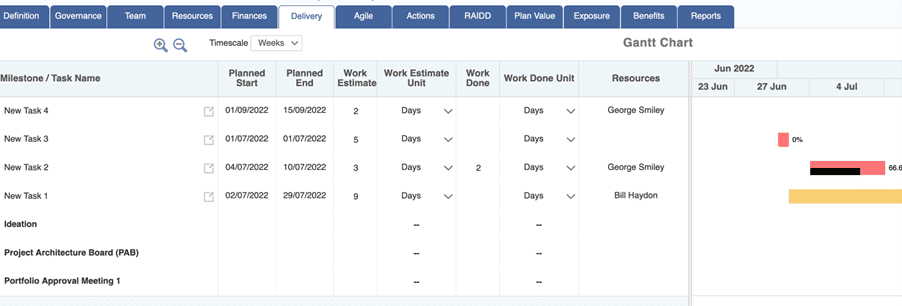
Gantt screen in PM3 showing resources allocated by task.
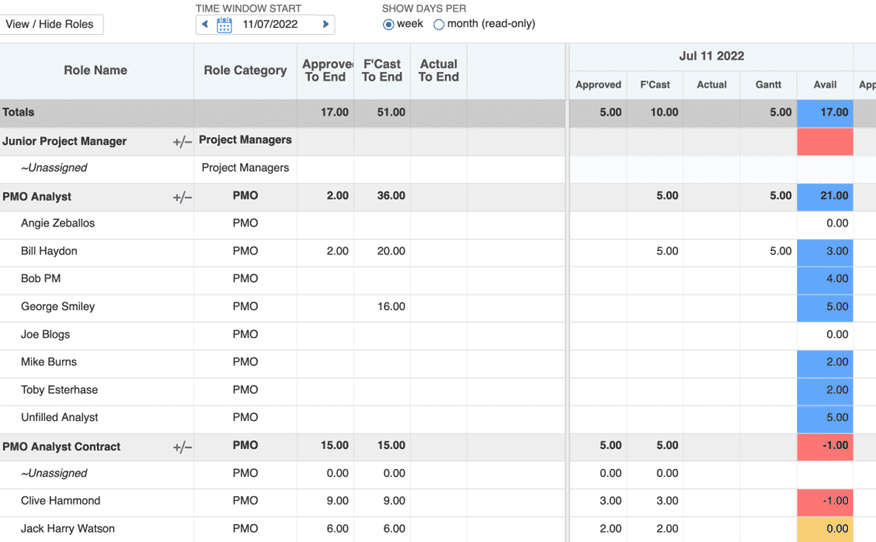
Resource screen in PM3 showing Gantt resource allocations copied to ‘Forecast’
The other approach to resource planning is to get the project managers to complete a forecast sheet – in Excel – or in PM3 (shown below) that shows forecast demand by person and / or role by project. Of course, the Gantt chart will inform this forecast, but it is not driven by the detailed data in the Gantt.
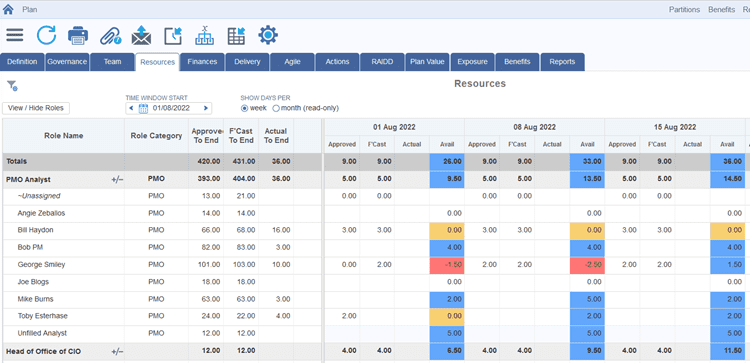
PM3 Resource Forecast Sheet – Summary
In both of these approaches, when all the project managers have uploaded their resource estimates, PM3 will add these up to give an aggregate demand forecast across the portfolio.
This aggregate demand by person and by role is then compared to the capacity. In PM3, this can be viewed in tabular form or in graphical form.
Examples of these PM3 screens are shown below.
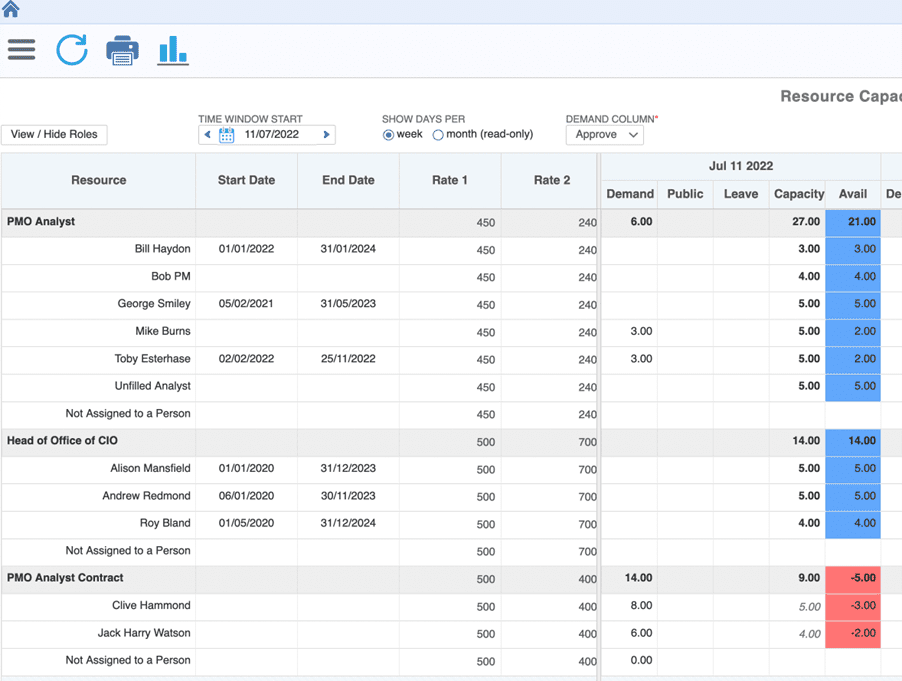
PM3 Tabular Screen showing overallocated (red) resources
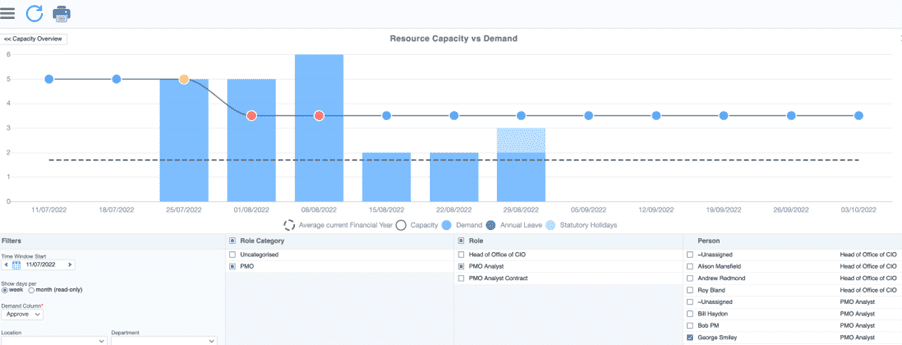
PM3 graphical Screen showing over allocated resources.
Once you have the data summarised then you would typically – with both approaches – meet with the project managers, portfolio owners and the resource pool owners.
It is a mistake to move resource allocations around using a tool without this essential meeting; it is not a mechanistic process.
At this meeting the workforce manager would ask these typical questions of a project manager(s) who have over- allocated resources:
In PM3 we have role category that has similar resources, that can be used to check whether a resource who may be overloaded can be substituted by another similar resource in a different resource group.
For example, you may have a business analyst category that has two roles in it, e.g. junior business analyst and senior business analyst.
If there is an excess of demand of senior business analysts, the resource manager can speak to the project managers and see if anyone else in the resource category, e.g. junior business analyst can fulfil the role.
If the junior analyst can fulfil the role, then this will reduce the ‘demand’ of the senior business analyst which could mean that the capacity of senior business analyst is not exceeded.
The output of this meeting is a (hopefully) united way forward in levelling resources and also a forward plan of hiring staff where there is clearly a long-term shortfall of a particular resource type.
This resource meeting is, in our experience, usually a monthly event.
There is no right or wrong answer to which approach is best for resource / capacity planning.
Detailed or high-level?
In many organisations, the high-level approach is more effective, less time consuming and gives reasonably accurate results.
Either approach can be used with PM3, our PPM tool, but using the 80:20 pareto rule; most of the benefits of effective resource management can be gained from the high-level approach.
It is also a lot less work!

Our products help you deliver successful change programmes and projects by always focusing on the overall business outcomes. Find out how our products can help you.
get in touch See a demoAre you struggling to understand how to plan a project that keeps you and your team on target? In th...
Read more >Having many years experience in implementing PPM tools for our clients – typically our tool, PM3, ...
Read more >Learn why PPM solutions are becoming an essential tool within many businesses across a number of ind...
Read more >